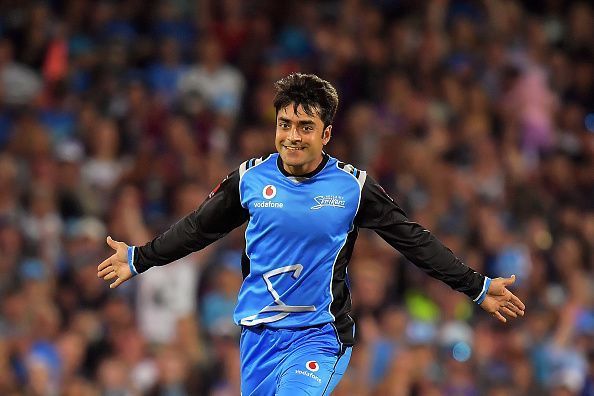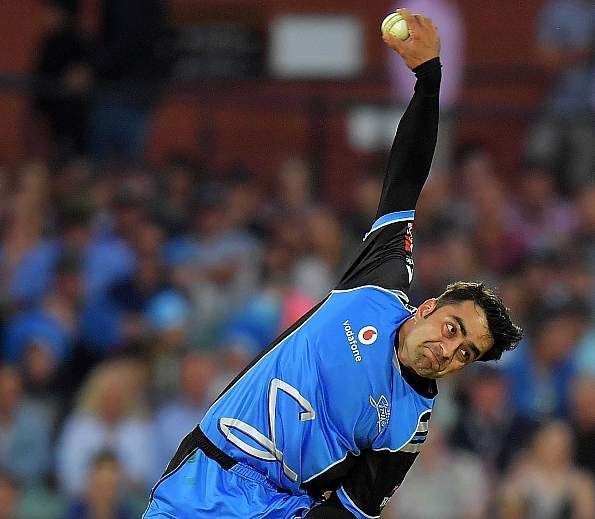
Rashid Khan: The poster boy of franchise cricket

Mohammad Rafique is a name that rings bells in the minds of very few cricket fans outside Bangladesh. His stats as per international standards are pretty ordinary; around 1200 runs with the bat to go with 125 wickets from 125 ODIs are surely nothing to boast about.
But cricket analysts who followed his game in the late 90s and early 2000s will vouch for the fact that the wily, deceptive left-arm spinner played a pivotal role in the Bangladeshi bowling attack back then. Rafique’s consistent ability to choke opposition batsmen in the middle overs, followed by picking up a wicket or two, made him an indispensable member of the Bangladeshi XI during that era.
The way he foxed decent players of spin like Sanath Jayasuriya, Marwan Atapattu, Saeed Anwar and Sourav Ganguly with flight, only reinforced the tremendous skill and potential he possessed. To add to his bowling, he would often chip in with handy contributions lower down the order, lifting the team total to respectable levels.
It was often said that Rafique was born in the wrong country. Had he been born in any other country of the subcontinent, he would have played many more matches as the lead bowling all-rounder of the team.
Rashid Khan could well have gone on to become another Mohammad Rafique, had franchise cricket not made its entry into the global cricketing scenario through the IPL in 2008.
Rashid Khan: Decoding the mystery
Rashid has been setting global T20 leagues on fire since 2017, winning matches single-handedly for his respective franchises in IPL, BBL, CPL and BPL. He has been consistently bamboozling international batsmen of the class of MS Dhoni, Virat Kohli, AB de Villiers, Aaron Finch and Chris Gayle with his variations; it seems batsmen are yet to come up with a set plan against him.
Rashid's consistent success at the topmost level, and that too against such famed batsmen, is by no means a fluke. It is important to understand that unlike Sunil Narine, Rashid has no mystery delivery. He bowls the three standard variations of a leg-spinner - the leg break, the googly and the flipper.
But the catch is that a standard leg-spinner bowls the leg-spinning ball from the front of the hand and the googly from the back of the hand. So batsmen who are good players of spin, pick the ball (whether it's leg-break or googly) from the bowler's hand, and play it accordingly.
Rashid, however, bowls both the leg-spinner and the googly from the back of the hand, with an extremely quick arm action. That makes it next to impossible for the batsmen to pick him from the hand.
The pace that Rashid imparts on the delivery ensures that the batsman cannot afford to survive by reading him off the pitch. That is the reason why, in spite of so much scrutiny and analysis, Rashid is still running through opposition lineups with relative ease.

Is Rashid a legend in the making?
While the entire coterie of cricket fans are losing their minds over this spin necromancer, already terming him as a legend in the making, that might be a bit of an exaggeration at the moment.
A closer look at legendary spinners, starting from BS Chandrasekhar and Bishen Singh Bedi to the likes of Muttiah Muralitharan, Shane Warne, Anil Kumble and Saqlain Mushtaq, reveals that after their initial few years in international cricket, quality batsmen always learned to pick their variations.
For instance, by the time Muralitharan had completed 6-7 years in international cricket, the good players of spin had started picking his doosra and off-break from the hand. Muralitharan continued to pick truckloads of wickets owing to his deception in flight, variation of pace, accurate line and length as well as reading the psyche of the batsmen.
Warne was no different. He never picked up wickets because batsmen were in confusion regarding whether he was bowling a googly or a leg spinner. He picked up wickets owing to his flight, drift, effective use of flippers along with immense control over line and length, in spite of being a wrist spinner.
In fact, for the 'ball of the century', Mike Gatting picked Warne from the hand, and knew that the ball was a standard leg-spinning delivery. It was the steep angle of the turn, that Gatting failed to predict.
The point that can be inferred from all these explanations is pretty simple. Once a spinner has spent a decent period (4-5 years) in international cricket, batsmen invariably find a way to read his variations, no matter how good he is. This has happened with the legends of the game and this will happen to Rashid as well.
Therefore, his main weapon i.e. the similarity between his leg spin and googly, will become ineffective in a matter of a few years. It will be important to see how Rashid responds to that, more so because presently, he rarely flights the ball, and hence almost never picks up wickets by deceiving the batsmen in the air.
But Rashid need not look far for inspiration. Flight and deception in the air have not been the only way legendary spinners have picked up wickets. Among the flight and the guile and the drift of the Mushtaq Ahmeds, the Bishen Bedis, the Warnes, there was this one 19-year-old kid, with nerdy glasses, who debuted in 1990 against England at Old Trafford and ripped apart opposition lineups for the next 18 years with his non-flighted, accurate 'spin' bowling.
He went on to pick up 619 Test wickets throughout his illustrious career - the veteran magician with the ball, Anil Kumble.
Rashid's bowling is quite similar to Kumble's. But Kumble's secret to success was his unerring accuracy with his line and length, along with variations in pace. These were features that were sustainable enough for him to last an entire career of 18 years, with utmost consistency.
Whether Rashid will be able to bring this aspect of his game to the fore once the batsmen start reading him, is something that all cricket fans are eagerly waiting to see. That being said, even if Rashid achieves half of what Kumble achieved in his career, he would likely consider himself the best bowler of his generation.